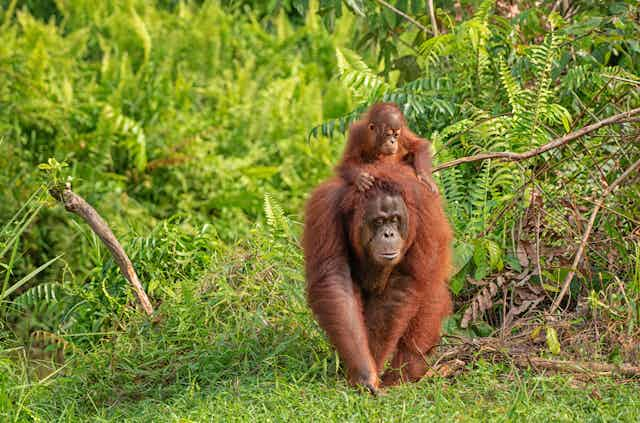We have always known that orangutans infants are very dependent on their mothers in their early years. But it turns out that orangutan mothers also change their own behaviour to help their children learn and become independent as quickly as possible.
Primate culture has fascinated many of us who study animal behaviour since we learned back in the 1990s how chimpanzee behaviour varies across Africa. This discovery gave rise to the possibility that apes might have their own “culture”, something that was once considered to be the definition of humanity. Since then, we have tried to draw comparisons between learning methods used by our offspring and those exhibited by apes.
So-called proactive teaching, where a learner is deliberately taught by a parent – usually by demonstration – is less common in humans than we might think, outside of formal education. Instead, we learn by copying the actions of our parents to allow us to replicate these behaviours in our own lives.
In contrast, the great apes – orangutans, gorillas, chimps and bonobos – learn by using an intriguing mix of individual learning through play and non-copying social learning, such as enhancement – when an object (or location) becomes more interesting to one ape because they have seen another ape using it.
A helping hand from mum
Orangutans have an interesting social life. In contrast to the rest of the great apes, they live semi-solitary existences, and for the first eight years of their life are dependent on their mothers. Through support, mum can help them to acquire the skills needed to survive and thrive in their canopy habitat in the forests of Borneo and Sumatra, Indonesia.
For example, they need to learn how to move between the trees in the same way that their mothers do. Orangutans appear to learn adult-type movement by about age seven. This is after years of assistance from mum, which is tailored to the infant’s level of development, as well as a good amount of individual exploration through play.
Orangutans have a complex and varied diet and the food sources they rely on appear to follow almost no pattern. But through trial and error, and a bit of help from mum, young orangutans learn how to exploit the forest for food. They also routinely use tools to access high-reward fruits, such as the neesia, and these skills do not develop overnight.
Why infants beg for food
So, if we are to find formal evidence in apes of human-like teaching – by demonstration and copying – then orangutans are probably the apes to watch. That was the logic behind a recent study on infant learning through “solicitation” – that’s when a young, inexperienced ape begs or asks for food from their mother to help them learn what and how to eat.
Researchers wanted to investigate the effect of various factors, including the offspring’s age and the complexity of food on a mother orangutan’s behaviour towards her young offspring. Food complexity was measured by the number of steps it took to process the food item before it could be ingested – from simply plucking and eating leaves to complicated tool use on the neesia fruit. The researchers followed 27 immature orangutans in Sumatra for more than 4,000 hours over a four-year period and recorded the conditions surrounding the 1,390 solicitation attempts they observed.
Despite the infants’ best attempts, the researchers found that mother orangutans were less likely to share food with them in the first year or so of their life when they were weaning, meaning the success of food solicitation was low.
However, after the infant began to consume solid food, their attempts became far more successful with a sharp increase in the number of times their mother agreed to share food. Then, as the infants grew older, their requests for food started to get less successful again. After the offspring reached the age of five, the rate of maternal assistance took a bit of a nosedive, most extremely in the case of more complex foods such as the neesia fruit or the meat of small invertebrates.
As their offspring grew older, Sumatran orangutan mothers seemed to become less willing to help them eat. The researchers suggest this could be due to the mother changing her behaviour to provide the correct level of guidance required for the infant to become independent as quickly as possible.
They liken this to scaffolding in humans, where parents will initially provide a child with lots of support in the early stages of learning a skill but then that support is gradually withdrawn until the infant is operating independently. But, the researchers don’t assume that what they observed in orangutans is intentional in the same way as human teaching is.

The orangutan mother’s change in behaviour might provide an evolutionary advantage. They only reproduce again once their current offspring has gained a large degree of independence – so, the faster this happens, the more offspring can be reared. Those mothers who are more tolerant and helpful, with offspring potentially gaining independence earlier, can reproduce more.
The authors do not imply that this is a conscious choice on the part of the mothers, as that cannot be known from the study. And as we do not know if it is intentional, we cannot say that it is evidence of human-like teaching. However, it’s an interesting development in the research surrounding social learning and culture in orangutans as it suggests that mothers play a more active role in developing the feeding skills of their immature offspring than previously assumed.
Rather than trying to apply our human labels to other species, we should simply learn to understand and celebrate the different form of culture that we observe in our closest living relatives. It is for this reason, and many others besides, that we must all do everything in our power to conserve these amazing animals.

